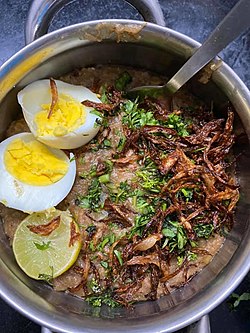
Back হায়দ্রাবাদি হালিম Bengali/Bangla Haleem de Hyderabad Spanish हैदराबादी हलीम Hindi Hyderabadi haleem JV ਹੈਦਰਾਬਾਦੀ ਹਲੀਮ Punjabi حیدرآبادی حلیم PNB ஐதராபாத்து கலீம் Tamil హైదరాబాద్ హలీమ్ Tegulu حیدرآبادی حلیم Urdu
 Hyderabadi mutton haleem garnished with cilantro, egg, fried onion, and lime | |
| Alternative names | Hyderabadi harees |
|---|---|
| Place of origin | India |
| Region or state | Hyderabad, Telangana |
| Associated cuisine | Indian |
| Created by | Originated from the Chaush (Hyderabadi Arabs)[1] |
| Main ingredients | Pounded wheat, lentils, goat meat, ghee, dried fruit and saffron |
| This article is part of the series on |
| Indian cuisine |
|---|
 |
Hyderabadi haleem (/ˈhaɪdərəbɑːdiː həˈliːm/) is a type of haleem popular in the Indian city of Hyderabad. Haleem is a stew composed of meat, lentils, and pounded wheat made into a thick paste. It is originally an Arabic dish and was introduced to the Hyderabad State by the Chaush people during the rule of the Nizams (the former rulers of Hyderabad State). Local traditional spices helped a unique Hyderabadi haleem evolve, that became popular among the native Hyderabadis by the 20th century.
The preparation of haleem has been compared to that of Hyderabadi biryani. Though Hyderabadi haleem is the traditional hors d'oeuvre at weddings, celebrations and other social occasions, it is particularly consumed in the Islamic month of Ramadan during Iftar (the evening meal that breaks the day-long fast) as it is high in calories. In recognition of its cultural significance and popularity, in 2010 it was granted Geographical Indication status (GIS) by the Indian GIS registry office,[2] making it the first non-vegetarian dish in India to receive this status. In October 2022, Hyderabadi haleem won 'Most Popular GI' award in the food category, that was chosen through a voting system that was conducted by the Department for Promotion of Industry & Internal Trade (under the Ministry of Commerce and Industry).[3]
- ^ Cite error: The named reference
times_Augwas invoked but never defined (see the help page). - ^ "On the food trail in Hyderabad, where Ramzan is incomplete without haleem". 6 June 2018. Archived from the original on 12 June 2018. Retrieved 6 June 2018.
- ^ "Hyderabad Haleem wins 'Most Popular GI' food award". The Times of India. 18 October 2022.